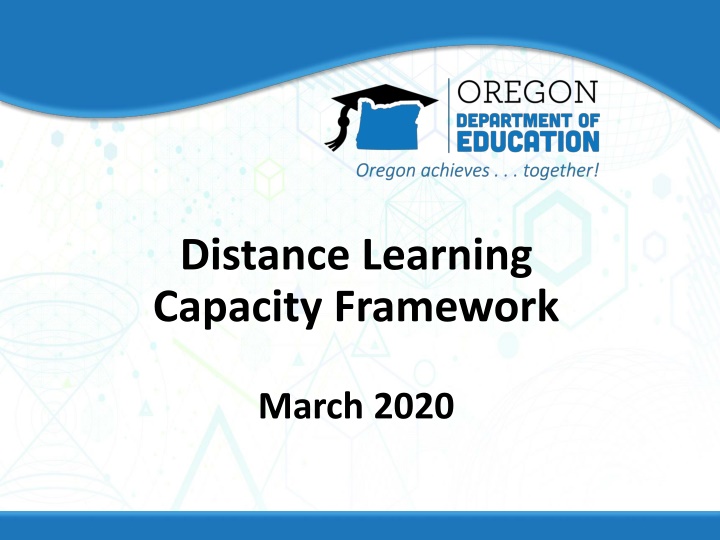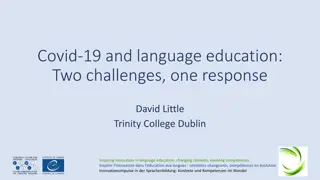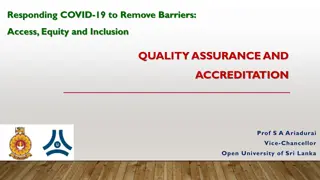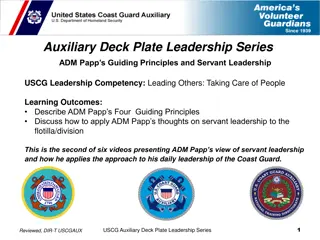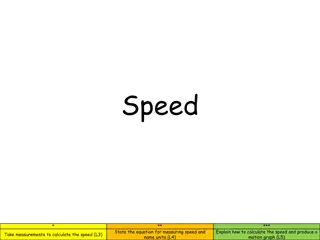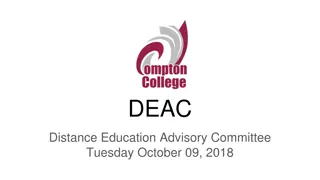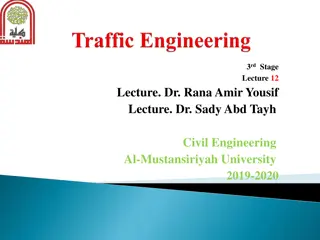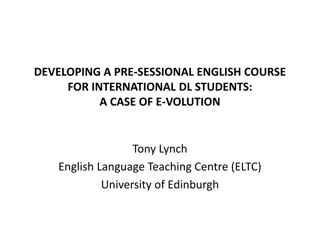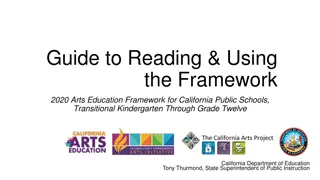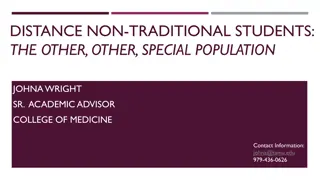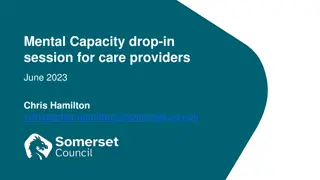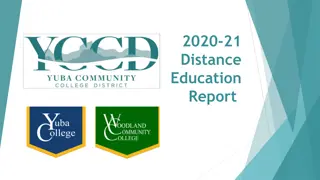Distance Learning Capacity Framework & Guiding Principles for Online Education
The Distance Learning Capacity Framework and Guiding Principles for online education emphasize safety, wellness, equity, and innovation in the educational process. It stresses the importance of connectivity, technology, educator efficacy, and student proficiency in online learning. These principles provide a roadmap for effective online education in Oregon, promoting belonging, student agency, and culturally sustaining practices.
Download Presentation

Please find below an Image/Link to download the presentation.
The content on the website is provided AS IS for your information and personal use only. It may not be sold, licensed, or shared on other websites without obtaining consent from the author.If you encounter any issues during the download, it is possible that the publisher has removed the file from their server.
You are allowed to download the files provided on this website for personal or commercial use, subject to the condition that they are used lawfully. All files are the property of their respective owners.
The content on the website is provided AS IS for your information and personal use only. It may not be sold, licensed, or shared on other websites without obtaining consent from the author.
E N D
Presentation Transcript
Distance Learning Capacity Framework March 2020
Guiding Principles As we lead this effort across Oregon, the Distance Learning for All Guiding Principles will anchor our state in common values and help generate collective action during this time: Ensure safety and wellness. Students need food, clothing, a safe place to learn and shelter, as well as a sense of care and connection, in order to engage in challenging intellectual work. Cultivate connection and relationship. Student connections and relationships with trusted adults promote belonging, which is especially important as learning takes place outside of the school setting. Center in equity and efficacy. Prioritize equity in every decision; build on cultural and linguistic assets to inspire learning and promote student efficacy. Consider how decisions and actions attend to racial equity and social justice (Oregon Educator Equity Lens). Consider the assets of students who experience disability. Innovate. Iterate through complex change with a spirit of possibility, centering in deep learning, student agency, and culturally sustaining practices.
Technology & Connectivity Capacity: Level Descriptors 5. Technology and digital tools for all students and staff, and consistent internet connectivity for all students and staff. TECHNOLOGY & CONNECTIVITY CAPACITY 4. Technology and digital tools for most grade bands and all staff, consistent internet connectivity for staff and most students. 3. Technology and digital tools for some grade bands and for all staff. Internet connectivity gaps for students and staff. 2. Some technology and digital tools and internet connectivity for students and staff. 1. Limited to no technology, digital tools, or internet connectivity for students and staff.
Educator Efficacy for Online Learning: Level Descriptors 1. The educator provides instruction and assessment through paper pencil methods and has little to no ability to instruct through an online format and/or with technology 2. The educator can provide limited access to basic instruction through an online format, has limited technology skills, and relies heavily on paper pencil methods for instruction and assessment to meet all learners needs 3. The educator has basic skills for instruction, limited student interaction, and assessment using an online format to meet all learners needs. Uses some technology, and may rely on some paper pencil methods 4. The educator has skills to use technology and digital tools to provide proficient instruction, some student interaction, and assessment in an online format with some technology in ways to meet most learners needs 5. The educator has advanced technology skills and can provide exemplary instruction, student interaction, and assessment in an online format with varying technology and methods in ways to meet all learners needs EDUCATOR EFFICACY FOR ONLINE LEARNING
Student Efficacy for Online Learning: Level Descriptors 1. Student has limited to no experience using technology tools for school learning. Students have not developed the fluency and skills needed to access online instruction. Time management and planning skills are emerging. Limited connections to classmates attempted. Teacher contacts student. 2. The student has emergent exposure in using technology and digital tools for learning, but does not have fluency in applying those skills. Time management and planning skills are developing. Classmate connections are infrequent. Teacher contacts student. 3. The student has developing fluency and basic skills using technology and digital tools to access and meet some learning goals in online instruction assignments. Time management and planning skills are sufficient. Classmate connections are common. Student contacts teacher infrequently. 4. The student has sufficient fluency and skills in using technology and digital tools to access and meet learning goals in online instruction assignments. Time management and planning skills are proficient. Classmate connections are consistent and productive. Student contacts teacher appropriately. 5. The student is able to fluently access technology and digital tools and has skills needed to extend uses beyond online instruction assignments. Time management and planning skills are strong. Classmate connections are consistent and productive. Teacher contacts are consistent and efficient. STUDENT EFFICACY FOR ONLINE LEARNING
ATechnology & Connectivity Capacity Emergent-Developing Educator & Student Efficacy for Online Learning Emergent-Developing Majority of students have access to phone and paper/pencil as primary learning tools at home and at school Majority of staff use paper/pencil, email, overhead projectors, and printed text to deliver content Professional learning has focused on offline instructional approaches A basic internal communications plan is in place to support initial awareness about online/blended learning strategies Classroom instruction is just beginning to incorporate online/blended learning Students have initial fluency and skill with technology and digital tools necessary to access online learning Capacity to provide accommodations and modifications to support offline student learning in compliance with IEP, 504, and EL requirements is present
BTechnology & Connectivity Capacity Emergent-Developing Educator & Student Efficacy for Online Learning Proficient-Strong Students have access to digital tools and/or a reliable connection to the Internet; phone and paper pencil are primary learning tools Curriculum plans incorporate online/blended learning strategies; implementation varies by classroom High quality professional learning focused on digital learning and/or technology tools has been provided A basic internal and external communications plan is in place to support awareness about online/blended learning strategies Students have developed fluency and skill with technology and digital tools. Online connections with classmates are present. Students connected to teachers electronically Capacity to deliver accommodations and modifications to support student learning in compliance with IEP, 504 and EL requirements is present
CTechnology & Connectivity Capacity Proficient-Strong Educator & Student Efficacy for Online Learning Emergent-Developing Access to a robust and scalable online platform/LMS to deliver online/blended instruction is provided to teachers and students; efficacy in using those tools is emergent to developing Staff and students have received training on how to use the online platform/LMS and related tools and have access to helpdesk services; pockets of excellence exist in some schools with some teachers A communications plan is in place to support awareness about online/blended learning strategies. The plan was developed with significant input from teachers, staff, students, parents, and community members Students have the fluency and skill to use some, but not all, technology and digital tools that are necessary to access online instruction; student ability to leverage classmates and teachers for support is emergent to developing Teachers and students are provided with technology, digital tools, and connectivity needed to effectively support online learning; however, efficacy in using those resources is emergent to developing
DTechnology & Connectivity Capacity Proficient-Strong Educator & Student Efficacy for Online Learning Proficient-Strong Leadership has a clear and sustainable vision and practice that all educators effectively use online/blended learning to personalize learning for students Access to and experience using a robust and scalable online platform/LMS to deliver online/blended instruction is provided to students; the district has the capacity to conduct online meetings with staff, parents, and students Teachers, students and parents have been provided sufficient training on how to use the online platform/LMS and related tools and have access to helpdesk services A robust multi-media communications plan is in place to support awareness about online/blended learning strategies. The plan was developed with significant input from teachers, staff, students, parents and community members Learner-appropriate and accessible online content and resources are used to create personalized learning plans that enable authentic learning opportunities Students have the fluency and skills needed to successfully use all technology and digital tools that are necessary to access and benefit from online learning; student is able to leverage teacher and classmates as supports efficiently Teachers and students have the technology, digital tools, and connectivity needed to effectively support online learning, in addition to IEP, 504, and EL requirements
ODEs Goal for Distance Learning for All ODE s goal is that all students will maintain a connection to their teacher(s), feel grounded in their sense of well-being and mental health, feel connected and valued as important members of their learning communities, and, once the conditions for reinforcing learning are present, continue to read, write, communicate, think critically, problem-solve, and engage in varied learning experiences during this school closure period. Educators play a critical role in maintaining connection with students, while schools are closed. Activities will be available across all instructional areas, so each child may choose activities that suit their interests. Contact: DistanceLearning4All@ODE.state.or.us
